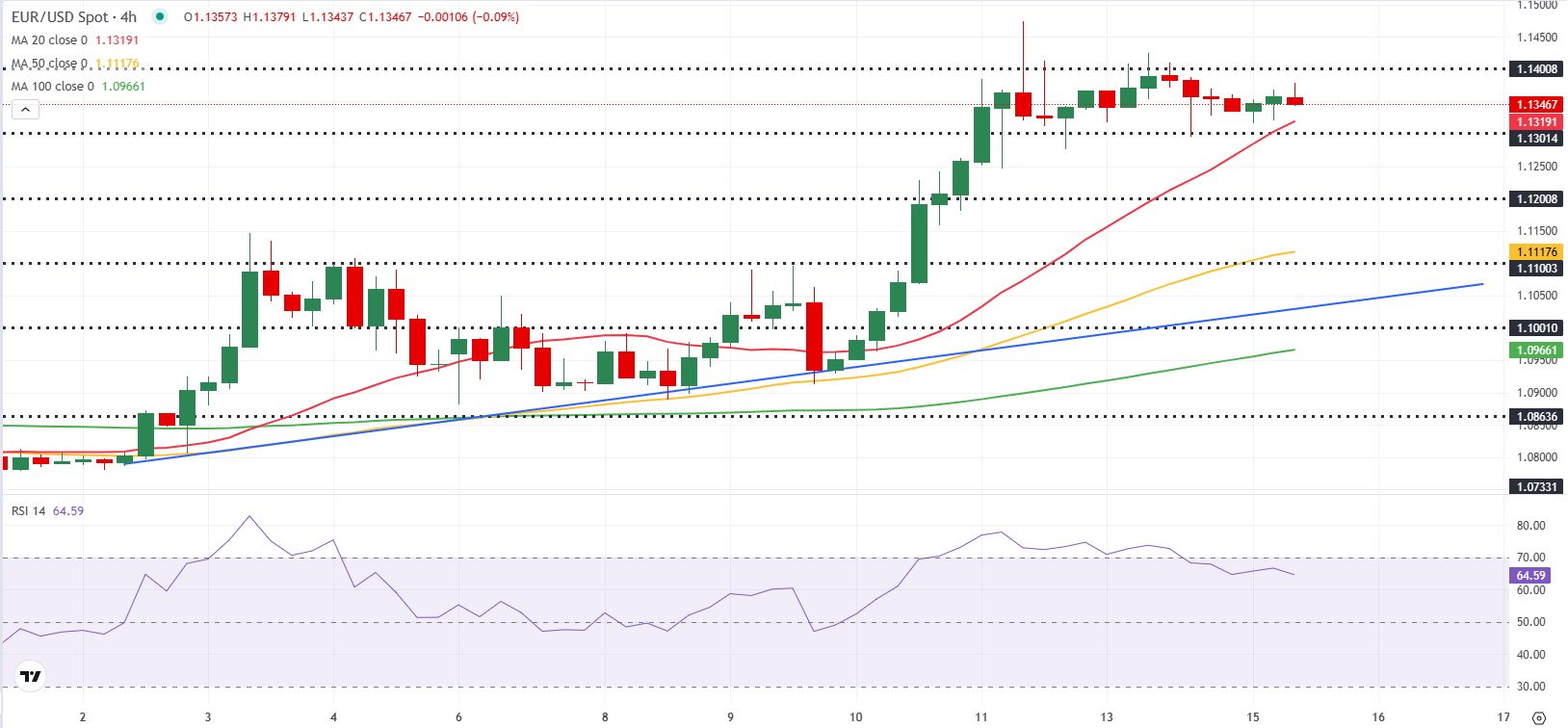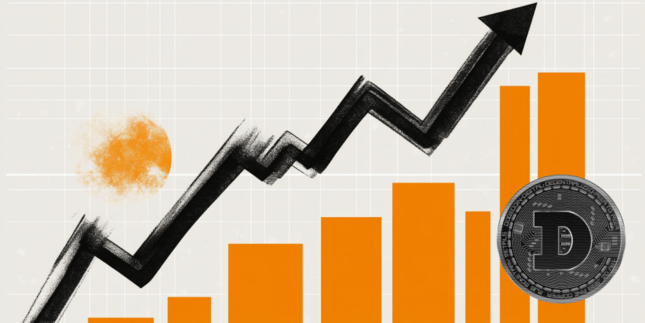- EUR/USD fluctuates in a narrow band below 1.1400 on Tuesday.
- The bullish bias remains intact in the short-term technical outlook.
- Investors could refrain from taking large positions ahead of the ECB's policy announcements.
EUR/USD moves up and down in a narrow channel at around 1.1350 after posting small gains on Monday. The pair's near-term technical outlook suggests that the bullish bias remains intact but investors could remain on the sidelines, waiting for the European Central Bank's (ECB) monetary policy announcements due Thursday.
Euro PRICE Last 7 days
The table below shows the percentage change of Euro (EUR) against listed major currencies last 7 days. Euro was the strongest against the US Dollar.
| USD | EUR | GBP | JPY | CAD | AUD | NZD | CHF | |
|---|---|---|---|---|---|---|---|---|
| USD | -3.87% | -3.84% | -3.45% | -2.77% | -5.79% | -6.31% | -5.36% | |
| EUR | 3.87% | -0.02% | 0.39% | 1.13% | -2.00% | -2.50% | -1.56% | |
| GBP | 3.84% | 0.02% | 0.42% | 1.17% | -1.97% | -2.48% | -1.47% | |
| JPY | 3.45% | -0.39% | -0.42% | 0.71% | -2.41% | -2.98% | -1.92% | |
| CAD | 2.77% | -1.13% | -1.17% | -0.71% | -3.11% | -3.61% | -2.59% | |
| AUD | 5.79% | 2.00% | 1.97% | 2.41% | 3.11% | -0.51% | 0.51% | |
| NZD | 6.31% | 2.50% | 2.48% | 2.98% | 3.61% | 0.51% | 1.04% | |
| CHF | 5.36% | 1.56% | 1.47% | 1.92% | 2.59% | -0.51% | -1.04% |
The heat map shows percentage changes of major currencies against each other. The base currency is picked from the left column, while the quote currency is picked from the top row. For example, if you pick the Euro from the left column and move along the horizontal line to the US Dollar, the percentage change displayed in the box will represent EUR (base)/USD (quote).
The improving risk mood helped EUR/USD hold its ground at the beginning of the week. On the other hand, the US Dollar (USD) found its footing following the previous week's steep decline and limited the pair's upside amid easing fears over a deepening global trade conflict.
In an interview with Fox Business Network on Monday, Kevin Hassett, Director of the United States (US) National Economic Council (NEC), said that they are making "enormous progress" on tariff talks with the European Union.
The US economic calendar will feature the Federal Reserve Bank of New York's Empire State Manufacturing Survey, alongside the Imports Price Index and Export Price Index data for March. A significant decline in the Empire State Manufacturing Index could revive concerns over an economic downturn in the US and caused the USD to come under renewed selling pressure with the immediate reaction.
Meanwhile, the data from the Eurozone showed that Industrial Production expanded by 1.1% on a monthly basis in February, surpassing the market expectation for an increase of 0.2%. On a negative note, ZEW Survey - Economic Sentiment slumped to -18.5 in April from 39.8 in March.
EUR/USD Technical Analysis

The Relative Strength Index (RSI) holds above 60 on Tuesday, suggesting that the bullish bias remains intact in the near term. Additionally, EUR/USD holds comfortably above the 20-period Simple Moving Average (SMA).
On the upside, 1.1400 (psychological level, static level) aligns as first resistance before 1.1470 (static level) and 1.1500 (round level). Looking south, first support could be spotted at 1.1340 (static level) ahead of 1.1300 (static level, round level) and 1.1250 (static level).
Euro FAQs
The Euro is the currency for the 19 European Union countries that belong to the Eurozone. It is the second most heavily traded currency in the world behind the US Dollar. In 2022, it accounted for 31% of all foreign exchange transactions, with an average daily turnover of over $2.2 trillion a day. EUR/USD is the most heavily traded currency pair in the world, accounting for an estimated 30% off all transactions, followed by EUR/JPY (4%), EUR/GBP (3%) and EUR/AUD (2%).
The European Central Bank (ECB) in Frankfurt, Germany, is the reserve bank for the Eurozone. The ECB sets interest rates and manages monetary policy. The ECB’s primary mandate is to maintain price stability, which means either controlling inflation or stimulating growth. Its primary tool is the raising or lowering of interest rates. Relatively high interest rates – or the expectation of higher rates – will usually benefit the Euro and vice versa. The ECB Governing Council makes monetary policy decisions at meetings held eight times a year. Decisions are made by heads of the Eurozone national banks and six permanent members, including the President of the ECB, Christine Lagarde.
Eurozone inflation data, measured by the Harmonized Index of Consumer Prices (HICP), is an important econometric for the Euro. If inflation rises more than expected, especially if above the ECB’s 2% target, it obliges the ECB to raise interest rates to bring it back under control. Relatively high interest rates compared to its counterparts will usually benefit the Euro, as it makes the region more attractive as a place for global investors to park their money.
Data releases gauge the health of the economy and can impact on the Euro. Indicators such as GDP, Manufacturing and Services PMIs, employment, and consumer sentiment surveys can all influence the direction of the single currency. A strong economy is good for the Euro. Not only does it attract more foreign investment but it may encourage the ECB to put up interest rates, which will directly strengthen the Euro. Otherwise, if economic data is weak, the Euro is likely to fall. Economic data for the four largest economies in the euro area (Germany, France, Italy and Spain) are especially significant, as they account for 75% of the Eurozone’s economy.
Another significant data release for the Euro is the Trade Balance. This indicator measures the difference between what a country earns from its exports and what it spends on imports over a given period. If a country produces highly sought after exports then its currency will gain in value purely from the extra demand created from foreign buyers seeking to purchase these goods. Therefore, a positive net Trade Balance strengthens a currency and vice versa for a negative balance.
(This story was corrected on April 15 at 09:41 GMT to say that ZEW Survey - Economic Sentiment slumped to -18.5 in April, not February.)
Information on these pages contains forward-looking statements that involve risks and uncertainties. Markets and instruments profiled on this page are for informational purposes only and should not in any way come across as a recommendation to buy or sell in these assets. You should do your own thorough research before making any investment decisions. FXStreet does not in any way guarantee that this information is free from mistakes, errors, or material misstatements. It also does not guarantee that this information is of a timely nature. Investing in Open Markets involves a great deal of risk, including the loss of all or a portion of your investment, as well as emotional distress. All risks, losses and costs associated with investing, including total loss of principal, are your responsibility. The views and opinions expressed in this article are those of the authors and do not necessarily reflect the official policy or position of FXStreet nor its advertisers. The author will not be held responsible for information that is found at the end of links posted on this page.
If not otherwise explicitly mentioned in the body of the article, at the time of writing, the author has no position in any stock mentioned in this article and no business relationship with any company mentioned. The author has not received compensation for writing this article, other than from FXStreet.
FXStreet and the author do not provide personalized recommendations. The author makes no representations as to the accuracy, completeness, or suitability of this information. FXStreet and the author will not be liable for any errors, omissions or any losses, injuries or damages arising from this information and its display or use. Errors and omissions excepted.
The author and FXStreet are not registered investment advisors and nothing in this article is intended to be investment advice.
Recommended Content
Editors’ Picks

EUR/USD drops below 1.1400 after Germany and EU PMI data
EUR/USD struggles to hold its ground and trades below 1.1400 in the European session on Wednesday. PMI data from Germany and the Eurozone showed that the business activity in the service sector contracted in April. Markets await comments from central bankers and US PMI data.

GBP/USD stays weak near 1.3300 after disappointing UK data
GBP/USD stays under bearish pressure near 1.3300 in the European session on Wednesday. Pound Sterling struggles to find demand following the weaker-than-forecast April PMI data from the UK. BoE Governor Bailey will speak later in the day and the US economic calendar will feature PMI reports.

Gold price touches fresh weekly low, below $3,300 amid easing US-China trade tensions
Gold price extends its steady intraday descent through the first half of the European session and momentarily slips below the $3,300 mark in the last hour as the upbeat market mood conditions undermine demand for safe-haven assets.

Dogecoin lead double-digit gains across meme coins, with Shiba Inu, PEPE and BONK skyrocketing to new monthly highs
Top meme coins Dogecoin, Shiba Inu, PEPE and BONK lead the meme coin sector with double-digit gains on Wednesday following the crypto market recovery.

Five fundamentals for the week: Traders confront the trade war, important surveys, key Fed speech Premium
Will the US strike a trade deal with Japan? That would be positive progress. However, recent developments are not that positive, and there's only one certainty: headlines will dominate markets. Fresh US economic data is also of interest.

The Best brokers to trade EUR/USD
SPONSORED Discover the top brokers for trading EUR/USD in 2025. Our list features brokers with competitive spreads, fast execution, and powerful platforms. Whether you're a beginner or an expert, find the right partner to navigate the dynamic Forex market.